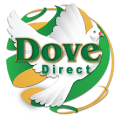Dove Direct Print and Marketing Blog, “Creating New Market Space”
Welcome to the Dove Direct Print and Marketing Blog. Today's post, "Creating New Market Space" examines why marketers should consider moving away from head-to-head competition and focus on creating a blue ocean strategy. Creating new market space may appear to be a next to impossible endeavor for any entrepreneur, small business, mid-size or even enterprise-size organizations to achieve. The concept behind creating new market space away from the competition lies within the book, Blue Ocean Strategy, of which authors W. Chan Kim and Rene´e Mauborgne stake their claim that competing in hyper-competitive markets is counterproductive when compared to blue oceans.
We've all been privy to various levels of competitive strategies that compete in crowded marketplaces. It's likely that at some point brands have been confronted with market strategies built around the case of competing as a king in a small pond versus a minnow struggling to survive in a huge ocean. The Blue Ocean Strategy serves as a course of action for brands to identify and compete in less crowded waters.
While time and space do not allow us to review the entire scope of a Blue Ocean Strategy in this article, we find it useful to focus on the paths that can lead one to new territory and unconventional performance indicators. The conventional boundaries of competition have been and will continue to permeate the market landscape; however, for many brands, conventionalism is the endpoint and therein lies the problem. To that end, the overall objective for new market creation is the ability to envision a reconstruction of those conventional competitive boundaries.
Blue Ocean Discovery
Changing the mindset of always relying upon and implementing the latest trends is the first step to avoid. The blue ocean strategy discovery process falls outside of predicting or appropriating industry trends. Moreover, the blue ocean strategy is not a trial-and-error mindset, where brands implement a succession of new business ideas at the whim of an executive under the influence of the latest shiny new object.
Conversely, C-suite executives and upper management need to engage in a structured process that presents a reordering of the existing market realities that changes the fundamentals, thus entering a new way of thinking. The opposite of the blue ocean is the red ocean where the head-to-head competition resides. Reconstructing existing market foundations across marketing and industry limits can free brands from the head-to-head competition.
The 6 Paths
There are six paths necessary to build a blue ocean strategy, and the process and planning should address these six paths. To delineate the divergent paths between head-to-head competition and blue ocean creation, brands need to see and understand the differences. We'll refer to "head-to-head competition" as HTHC, and "blue ocean creation" as BOC.
Path Number One begins with the industry, which the HTHC focuses on competitors within the industry, whereby BOC looks across alternative industries. Therefore, brands need to import the vision to ascertain those alternative industries that make the most sense to pursue.
Path Number Two brings strategic groups into focus. HTHC is primarily concerned with the brand's competitive position or marketshare within the industry. BOC ignores the competitive positioning mantra and instead opts to look across various strategic groups within the industry. Viewing the industry as a whole presents a more comprehensive picture of an industry's overall strategy. For example, the Retailers Association is made up of various strategic groups that share multiple strategies to ensure the industry is moving forward.
Path Number Three's priority is about the buyer group. The HTHC mentality makes the buyer group of an industry its top concern; along with a strategy that can elevate better service for that buyer group. BOC's approach is very different in that it redefines the industry buyer group instead of focusing on better services for a particular buyer group.
Path Number Four is about product scope or service offerings. The red ocean or HTHC strategy seeks to maximize the value of its product and service offerings within the boundaries of a particular industry. The blue ocean or BOC strategy looks across complementary product and service offerings. For example, one could argue that Walmart employs an HTHC strategy whereas Amazon is more BOC with its strategy of allowing sellers to sell on its website and now its brick-and-mortar locations.
Path Number Five speaks to functional-emotional orientation. The red ocean or HTHC strategy focuses on improving price performance within the functional-emotional orientation of the industry. On the other hand, the BOC pivots from this orientation. Consider the functional-emotional orientation of Ringling Bros. versus Cirque du Soleil. One provides animals and a low price point whereas the other offers value-priced artistic productions.
Path Number Six deals with time. The red ocean or HTHC strategy focuses on adapting to external trends as they occur. Remember, most competitors react to trends. A blue ocean or BOC strategy looks to shape external trends over time. Executing path number six is vital to creating a blue ocean strategy. Two examples in the book refer to the iTunes Music Store which over time, has changed the behavior of music sales and Cisco Systems with its recognition of consumer behavior and the need for seamless technology.
Time Trends
Cisco Systems successfully created a new market space by looking across time trends. High-speed data exchange was a thing of the future, and Cisco Systems noticed a clear, irreversible trend with an upward trajectory for high-speed data.
By observing that the state of data exchange was encumbered by slow data speeds and incompatible computer networks, with the number of internet users doubling every 100 days, Cisco recognized an opportunity to create products that provide real customer value while solving a problem. As a result, Cisco designed routers, switches and other networking devices that support fast data exchanges working across seamless environments. That ability to see the problem and shape a solution over time allows Cisco products to command over 80% of all internet traffic and gross profit margins in the 60 percentile group.
As a result, Cisco designed routers, switches and other networking devices that established a breakthrough customer value, in that fast data exchanges that could work in a seamless environment would solve the challenge. Cisco not only had the insight that reached across value innovation but also about technology. In today's world, Cicso products command over 80% of all internet traffic. Further, with this new market Cicso created, the gross profit margins in this new market space range in the 60 percentile group.
Irreversible Trends
Other brands applying path number six have created blue oceans. Take CNN, which created the first real-time 24-hour global news network based on the rise of globalization. HBO's successful hit program, "Sex and the City" was born out of the trend of the need for successful urban women to find love and marry later in life.
Identifying Irreversible Trends
It is essential to understand that there are trends and then there are irreversible events. The magic happens when organizations can identify trends that have a high probability of impacting industries and that demonstrate a clear trajectory. Organizations must ask themselves, how will these trends impact their industry? Can you identify or create an unprecedented customer utility? It's a challenge but the cornerstone of a blue ocean market.
The Net-Net
While this post scratches the surface of creating a blue ocean market space, we contend that the book "Blue Ocean Strategy" is well worth the time. If a brand can create a new market, then the competition becomes irrelevant, pricing can truly be a factor of the new market opportunity versus the competitor, and brands butting heads with the head-to-head competition are rendered irrelevant. Thank you for reading "Creating New Market Space."
Let's have a conversation about direct mail strategies, printing, print software, transactional documents, variable digital printing, brand equity and unified marketing collateral during our next Open House. We invite you to join us on Thursday, May 30th, 2018, for an hour or two, anytime between 10:30 am to 3:30 pm. Let us show you how to improve your document processes to optimize your workflow, reduce your costs, and maximize your organization's printing, letter shop and mailing capabilities. Dove Direct does have an official USPS certified bureau located within our offices that will save you time and money. And, if you bring us your files, we will create a demo file for you. For more information call Carla Eubanks at 404-629-0122 or email Carla at This email address is being protected from spambots. You need JavaScript enabled to view it..
Atlanta based print and mail solutions provider offers organizations end-to-end data, printing and mailing solutions: Data Management, Variable Digital Printing, LetterShop and Fulfillment, Fully Automated MLOCR Presort Bureau, Marketing and Production Management Support and Secure Data Life Cycle Management.
If you don't want to wait for the Open House, you can reach Dove Direct today by calling 404-629-0122 or use the contact form for Dove Direct.





